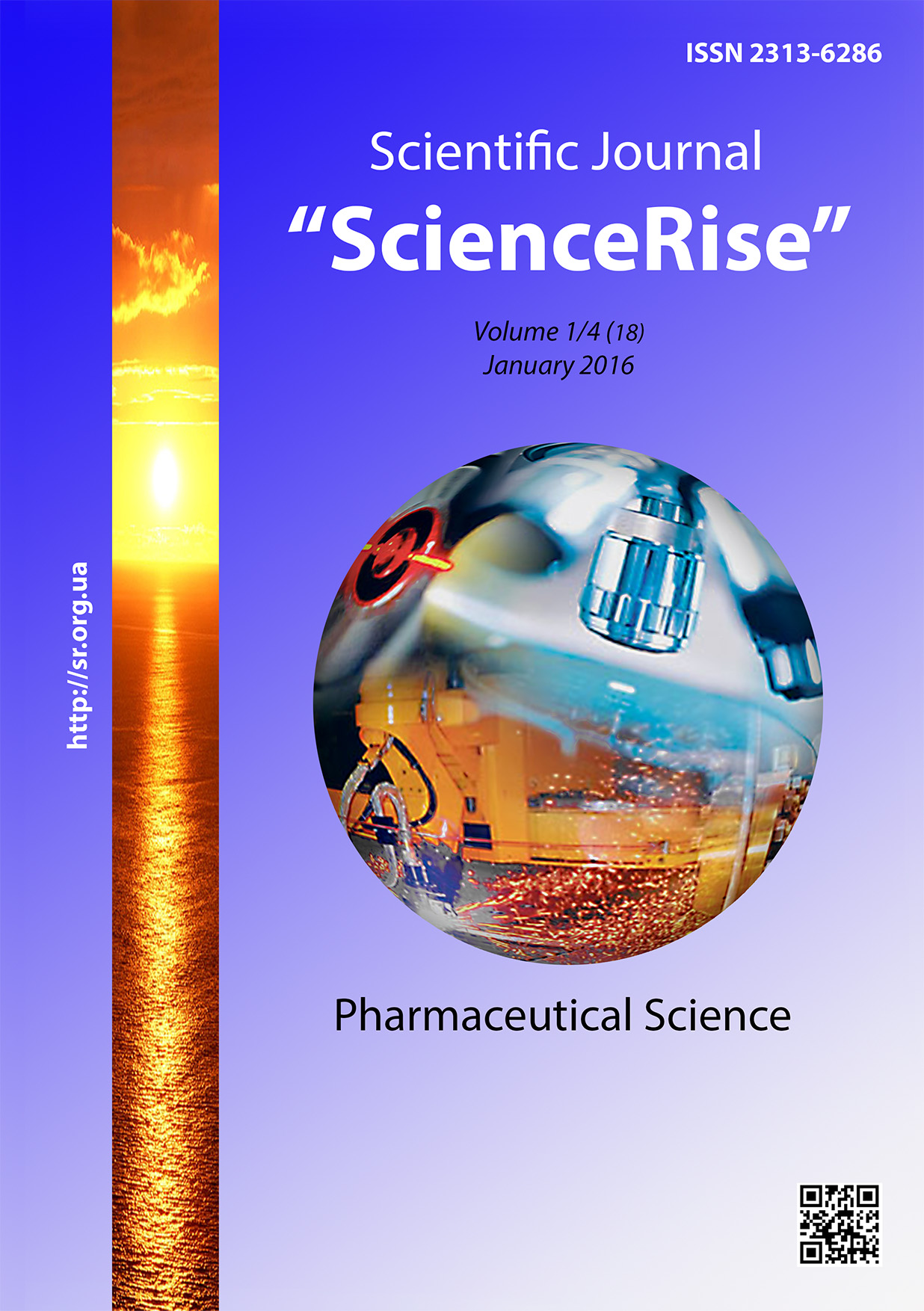Вивчення противірусної активності добавки дієтичної «Імуно-вірал з вітаміном С» щодо штаму вірусу грипу А/Вікторія
DOI:
https://doi.org/10.15587/2313-8416.2016.59131Ключевые слова:
антивірусна дія, добавка дієтична, рослинна сировина, сухі екстракти, вітамін С, капсулиАннотация
У пошуках ефективних засобів профілактики та боротьби з гострими респіраторно-вірусними інфекціями одним з перспективних напрямків є впровадження комбінованих засобів, які мають у своєму складі лікарську рослинну сировину, що виявляє протизапальну, антибактеріальну, противірусну, загальнозміцнювальну та імунотропну дію.
Мета. Метою нашої роботи було дослідження противірусної активності добавки дієтичної у формі твердих капсул «Імуно-вірал з вітаміном С» щодо штаму вірусу грипу А/Вікторія.
Методи. Був використаний класичний вірусологічний метод зараження курячих ембріонів у хоріон-алантоїсну оболонку, метод імунофлюоресценції для ідентифікації отриманого вірусу та реакція нейтралізації на курячих ембріонах.
Результати. Встановлено, що компоненти добавки дієтичної не токсичні для курячих ембріонів в розведеннях від 1:10 до 1:80; мають противірусну активність щодо прототипного штаму вірусу гриппу А/Вікторія в розведеннях від 1:10 до 1:20; летальну токсичну дозу – розведення 1:40. Після введення в курячі ембріони без інкубації з випробовуваним препаратом (пасирування) прототипного штаму вірусу грипу А/Вікторія засіб зберіг всі свої колишні характеристики, що підтверджує люмінесцентне забарвлення уражених ембріональних клітин, а також подальше вивчення пасированого штаму в реакції гальмування гемаглютинації з курячими еритроцитами.
Висновки. У результаті проведеної в експерименті реакції нейтралізації на 9–11 добових курячих ембріонах методом зараження в хоріон-алантоїсну порожнину з подальшою візуалізацією та ідентифікацією матеріалу, який містив вірус, методом імунофлюоресценції за специфічним світінням уражених клітин були встановлені антивірусні властивості компонентів добавки дієтичної «Імуно-вірал з вітаміном С»
Библиографические ссылки
Kramarev, S. O. (2007). Problemni pitannja infekcijnih hvorob v Ukrai'ni. Medichna gazeta Zdorov’ja Ukrai'ni, 1-2, 7–8.
Sidorenko, S. V., Jakovlev, S. V. (2003). Infekcii v intensivnoj terapii. Moscow: Bionika, 208.
Isakov, V. A., Chepik, E. B., Shamanova, M. G. et al. (1994). Smertnost' i letal'nost' ot grippa i ORZ. Vestnik RAMN, 6, 61–64.
Moskaljuk, V. D. (2010). Gryp. Diagnostyka, likuvannja, profilaktyka. Chernitsy, 176.
Bukrinskaja, A. G., Zhdanov, V. M. (1991). Molekuljarnye osnovy patogennosti virusov. Moscow: Medicina, 256.
Kuznik, B. I., Cybikov, N. N. (2009). Belki teplovogo shoka, ateroskleroz, DVS-sindrom i tromboz. Probl. klin. med., 1, 110–118.
Cherch, D. (2006). Kazhdomu po genomu. V mire nauki, 4, 30–39.
Avdeev, S. N. (2005). Ostryj respiratornyj distress-sindrom. Consilium Medicum, 4, 330–338.
Kassil', V. L., Vyzhigina, M. A., Sviridov, S. V. (2006). Chto takoe ostryj respiratornyj distress-sindrom: est' li smysl v diskussii ? Vestn. intensiv. ter., 4, 53–58.
Carenko, S. V., Dobrushina, O. R. (2008). Intensivnaja terapija ostrogo respiratornogo distress-sindroma. Moscow: Medicina, 176.
Kolomiec, A. G., Kolomiec, N. D., Lovickij, V. P. (1997). Jetiologicheskaja struktura respiratornyh virusnyh zabolevanij i sovremennye vozmozhnosti terapii. Klin. Medicina, 2, 6–12.
Nakaz MOZ Ukrai'ny «Pro zahody shhodo profilaktyky i borot'by z grypom ta gostrymy respiratornymy infekcijamy v Ukrai'ni» (2007). Ministerstvo Ohorony Zdorov'ja Ukrai'ny; vid 14.08.2007r. № 477. Available at: http://www.moz.gov.ua/ua/portal/dn_20070814_477.html
Kondratjuk, V. A., Kashuba, M. O., Dnistrjan, S. S. et al. (2010). Gigijenichni aspekty profilaktyky gostryh respiratornyh virusnyh infekcij. Infekcijni hvoroby, 4, 67–69.
Deeva, Je. G. (2008). Gripp. Na poroge pandemii: rukovodstvo dlja vrachej. Moscow: GJeOTAR–Media, 208.
Adekenov, S. M. (2003). Sovremennoe sostojanie i perspektivy proizvodstva otechestvennyh fitopreparatov i biotehnologicheskoj produkcii dlja mediciny. Farmacija Kazahstana, 2, 21–24.
Mustafa, A.-H., Martynov, A. V. (2010). Struktura i biologicheskaja aktivnost' nekotoryh rastitel'nyh jellagitaninov, vydelennyh iz raznyh predstavitelej roda mirtovyh. Annals of Mechnikov Institute, 4, 35–42.
Naprasnikova, G. S., Vladymyrova, I. M., Georgijanc, V. A. (2010). Rozrobka skladu novogo likuval'no-profilaktychnogo zasobu z antymikrobnoju ta protyzapal'noju aktyvnistju. Vol. 1. Farmacija Ukrai'ny. Pogljad u majbutnje. Kharkiv: NFaU, 313.
Hong, G., Dai, Y.-H., Liu, P.-X., Shen, X., Wei, Y.-Y., Li, G. (2008). Advances in research on chemical constituents and pharmacological activities of Agrimonia pilosa. Pharmaceutical Care and Research, 8 (5), 362–366.
Song, J.-M., Lee, K.-H., Seong, B.-L. (2005). Antiviral effect of catechins in green tea on influenza virus. Antiviral Research, 68 (2), 66–74. doi: 10.1016/j.antiviral.2005.06.010
Tsao, R. (2010). Chemistry and Biochemistry of Dietary Polyphenols. Nutrients, 2 (12), 1231–1246. doi: 10.3390/nu2121231
Загрузки
Опубликован
Выпуск
Раздел
Лицензия
Copyright (c) 2016 Ганна Сергіївна Шумова

Это произведение доступно по лицензии Creative Commons «Attribution» («Атрибуция») 4.0 Всемирная.
Наше издание использует положения об авторских правах Creative Commons CC BY для журналов открытого доступа.
Авторы, которые публикуются в этом журнале, соглашаются со следующими условиями:
1. Авторы оставляют за собой право на авторство своей работы и передают журналу право первой публикации этой работы на условиях лицензии Creative Commons CC BY, которая позволяет другим лицам свободно распространять опубликованную работу с обязательной ссылкой на авторов оригинальной работы и первую публикацию работы в этом журнале.
2. Авторы имеют право заключать самостоятельные дополнительные соглашения, которые касаются неэксклюзивного распространения работы в том виде, в котором она была опубликована этим журналом (например, размещать работу в электронном хранилище учреждения или публиковать в составе монографии), при условии сохранения ссылки на первую публикацию работы в этом журнале .

